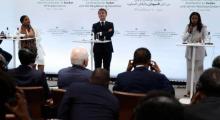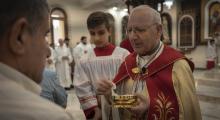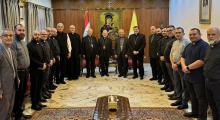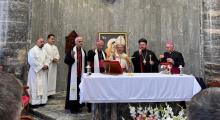Issued by the Catholic Center for Studies and Media - Jordan. Editor-in-chief Fr. Rif'at Bader - موقع أبونا abouna.org

Pope Francis is set to break a 15-month hiatus from international travel with what is sure to be a historic visit to Iraq. The Vatican released the itinerary of Francis’ March 5-8 visit to Iraq, his first foreign trip since being grounded for 16 months due to the coronavirus pandemic.
The 84-year-old pontiff, who has been vaccinated against COVID-19, apparently intends to go ahead with the trip despite the pandemic and lingering security concerns. Francis’ main reason for making the first-ever papal trip to Iraq is to encourage the country’s Christians, who faced decades of discrimination by Iraq’s Muslims before being persecuted by the Islamic State group starting in 2014.
Iraqi Christians see the papal historic visit as a massage of hope, reconciliation, common living, and a way forward to rebuilt Iraq. Since the 2003 U.S.-led invasion of Iraq, Christians have frequently been the target of attacks by Islamic extremists. Christian Communities in Iraq of Assyrians, Armenians, Chaldeans, Protestants, and Yazidis have been directly targeted when ISIS swept across the north and west of the country terrorizing the community and forcing tens of thousands to flee to the western countries, neighboring nations, or the northern Kurdish region.
In St. Joseph Chaldean Cathedral, one of the main churches in Baghdad, few worshippers were seen attending the Mass service, speaking inside the Cathedral Father Nazeer Deco, pastor of St. Joseph Chaldean Cathedral said the migration of Christians is due to extremism and internal problems in Iraq. Many of those who stayed in Iraq were isolated in neighborhoods protected by barricades and checkpoints.
Francis is expected to meet with Catholic priests and nuns in the Our Lady of Salvation Church, the site of a 2010 massacre that killed 58 people and was claimed by the al-Qaida in Iraq group, which later splintered into ISIS. Pictures of the victims of the church attack are displayed on the outside church wall as well as inside, near the altar to commemorate their memory. The attack is the worst on Iraq’s already dwindling Christian community causing thousands of Christians to flee their homeland.
The slow return of displaced Christians to northern Iraq since the territory was liberated from the Islamic State in 2017 remains a contentious issue. Few Christian families have returned but the Vatican has been encouraging those who fled to come back and ensure a continued Christian presence in the area that dates from the time of Christ. Unlike the Shiites, Sunnis and Kurds, Christian communities are scattered in small pockets throughout the country. The Chaldeans and Assyrians of Iraq are the two main Christian groups. Of the estimated 1.5 million Christians who lived in Iraq on the eve of the U.S.-led invasion, today, it is believed that only a third of that figure remains in Iraq though accurate estimations are hard to come by given the lack of census data in Iraq.







